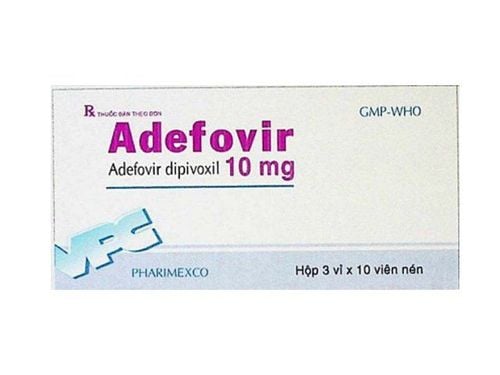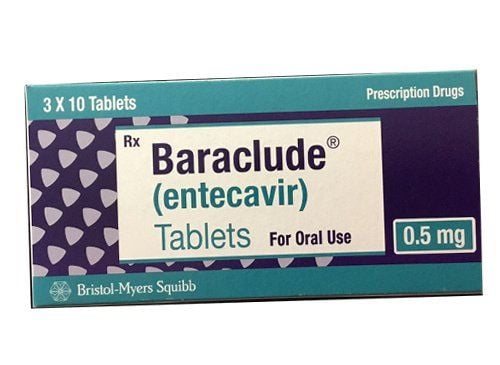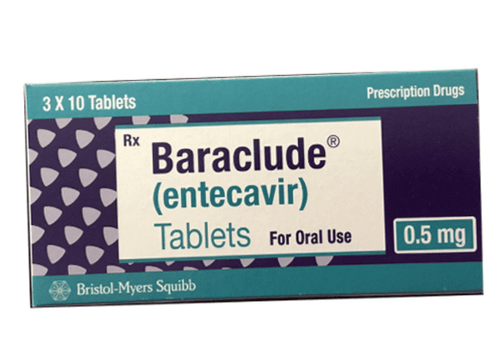This is an automatically translated article.
Hepbest medicine is made in the form of tablets, with the main ingredient being tenofovir alafenamide. Hepbest is used in the treatment of chronic hepatitis B virus infection in patients with compensated cirrhosis.
1. Uses of the drug Hepbest
What is Hepbest medicine? The active ingredient in Hepbest is tenofovir alafenamide 25mg. Tenofovir alafenamide is a phosphoramidate prodrug of tenofovir, which is permeable to lipophilic cells into hepatocytes. Through hydrolysis, tenofovir alafenamide is converted to tenofovir. Intracellular tenofovir is then phosphorylated to the metabolite tenofovir diphosphate. Tenofovir diphosphate inhibits the replication of HBV - hepatitis B virus.
Hepbest is indicated for: Treatment of chronic hepatitis B virus infection in patients with compensated cirrhosis.
Contraindications to the use of Hepbest: Patients with hypersensitivity to the drug's components.
2. How to use and dose of Hepbest
How to use: Take the whole Hepbest tablet with water, it should be taken with a meal.
Dosage:
Before starting treatment with Hepbest, it is necessary to determine if the patient has HIV-1 infection. The monotherapy component Alafenamide is not recommended for use in HIV-1-infected patients; It is necessary to test serum creatinine, creatinine clearance, blood phosphorus, urine glucose and proteinuria before, during treatment with Hepbest; Recommended dose: 1 tablet 25mg/time/day, taken with or without food; No dose adjustment of Hepbest is required in patients over 65 years of age; No dose adjustment of Hepbest is required in patients with mild to moderate renal impairment. It is not recommended to use the drug in patients with end-stage renal failure with ClCr less than 15ml/min. In hemodialysis patients, Hepbest should be administered after the end of dialysis; No dose adjustment of Hepbest is required in patients with mild hepatic impairment. Do not use the drug in patients with decompensated cirrhosis; Efficacy and safety studies have not been performed in patients under 18 years of age. Overdose: If an overdose occurs, the patient should be monitored for signs of tenofovir toxicity. General supportive measures include: Monitor the patient's vital signs and clinical status. Tenofovir can be eliminated by hemodialysis with a dialysis coefficient of about 54%.
Missed dose: If you forget to take a dose of Hepbest, you should take it as soon as you remember. If it is almost time for the next dose, skip the missed dose and take the next dose at the scheduled time.
3. Side effects of the drug Hepbest
When using Hepbest, patients may experience side effects such as: Headache, nausea, vomiting, diarrhea, flatulence, abdominal pain, fatigue, skin rash, back pain, increased liver enzymes (ALT, AST), increased LDL-cholesterol. When experiencing the above side effects or other symptoms not mentioned, the patient should stop taking the drug, notify the doctor or go to the nearest hospital for early treatment.
4. Be careful when using Hepbest
Some notes for patients to remember before and while taking Hepbest:
There have been cases of lactic acidosis and severe hepatomegaly with steatosis, and there have been cases of death when taking nucleoside analogues (tenofovir disoproxil). fumarate) in combination with antiretroviral drugs. The majority of cases were in women, especially those with obesity and prolonged nucleoside exposure. Therefore, caution should be exercised when using nucleoside analogues, especially in people with risk factors for liver disease. Hepbest should be discontinued in patients with clinical or laboratory signs suggesting lactic acidosis, marked hepatotoxicity; Discontinuation of anti-hepatitis B therapy can lead to a severe exacerbation of hepatitis B. After discontinuing Hepbest, patients should be closely monitored for clinical symptoms and frequent laboratory tests for at least several months. If necessary, continue treatment for hepatitis B; Due to the risk of developing HIV-1 resistance, do not use Hepbest units in HIV-1-infected patients. Safety and efficacy have not been established in patients coinfected with HBV and HIV-1. Therefore, anti-HIV antibodies should be tested before administering this drug to HBV-infected patients. If HIV-positive, a combination regimen with antiretroviral drugs is recommended; Renal failure (including acute renal failure and Fanconi's syndrome - renal tubular damage with severe hypophosphataemia) may have occurred with the use of tenofovir in vivo and in the trial. Clinically, this side effect does not occur; In patients taking the prodrug tenofovir and other nephrotoxic drugs, the risk of impaired renal function is increased; It is recommended to perform tests of blood phosphorus, serum creatinine, urine glucose, creatinine clearance, proteinuria before and during treatment with Hepbest; Use caution when using Hepbest in pregnant and lactating women, consult your doctor before using the drug.
5. Hepbest drug interactions
Drug interactions can affect the effectiveness of the drug or increase the risk of side effects. Some of Hepbest's drug interactions include:
Tenofovir Alafenamide is a substrate of P-glycoprotein (P-gp) and BCRP. Drugs that induce the activity of P-gp reduce absorption, reduce the concentration of Tenofovir Alafenamide in the blood, affecting the effectiveness of treatment. Drugs that inhibit the activity of P-gp and BCRP increase blood levels of Tenofovir Alafenamide and increase toxicity; Tenofovir is excreted mainly by the kidneys. Co-administration of Hepbest with drugs that reduce renal activity or compete for active tubular secretion (such as cidofovir, ganciclovir, valacyclovir, acyclovir, valganciclovir, aminoglycosides, high-dose NSAIDs, ...) increased blood concentration of tenofovir and increased toxicity; Antiepileptic drugs (oxcarbazepine, phenobarbital, carbamazepine, phenytoin), anti-tuberculosis drugs (rifabutin, rifampin) decrease blood levels of Tenofovir Alafenamide. The dose of Hepbest should be increased to 2 tablets of 25 mg/day when co-administered with carbamazepine. Other combinations are not recommended; Do not use Hepbest with drugs containing tenofovir disoproxil fumarate, tenofovir alafenamide, adefovir dipivoxil. When using Hepbest, patients should strictly follow the doctor's instructions on dosage, method of administration, and time of taking the drug. At the same time, patients should immediately report to the doctor if any unusual symptoms appear for timely treatment and support.
Follow Vinmec International General Hospital website to get more health, nutrition and beauty information to protect the health of yourself and your loved ones in your family.
Please dial HOTLINE for more information or register for an appointment HERE. Download MyVinmec app to make appointments faster and to manage your bookings easily.
HepBest 25mg
- Thành phần chính là Tenofovir Alafenamide dưới dạng Tenofovir Alafenamide Fumarate hàm lượng 25 mg cùng với tá dược gồm các thành phần Lactose monohydrat, Cellulose vi tinh thể, Croscarmellose natri, Magnesi stearat, Opadry II white 85F18422 vừa đủ 1 viên.
- Dạng bào chế: Viên nén
- Công ty đăng ký: Dược Phẩm Mylan Laboratories Limited - Ấn Độ
- Công ty sản xuất: Mylan
- Xuất xứ: Ấn Độ
- Số giấy phép lưu hành: VN3-251-19
>>> Xem chi tiết về sản phẩm và mua trực tuyến TẠI ĐÂY

Sản phẩm được phân phối chính hãng qua NHÀ THUỐC NGỌC ANH
Địa chỉ: 85 Vũ Trọng Phụng, Thanh Xuân, Hà Nội.
Hotline: 098 572 9595.
Lưu ý : người bệnh không tự ý sử dụng khi chưa có chỉ định của bác sĩ.













